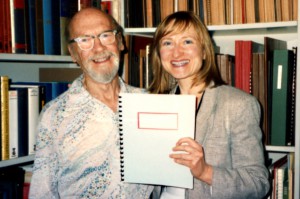Musician’s Statement
As a performer, I believe that my mission is to create through sound what the composer intended to be heard. Easier said than done! Discerning and achieving that intention in its specificity and generality requires a rare fusion of intellectual, emotional and imaginative faculties. I usually take a year to study a work I will perform, examining the score from a structural and harmonic point of view, and memorizing it in detail. I listen to other works by the composer, to understand his musical output in the context of his life and the music of the period. While placing the composer’s music within the performance practice of his time, I am seeking those elements which give his music its stylistic individuality and expressive content.
 Commissioning new music has been a major component of my musical life. It has provided the invaluable opportunity to have a dialogue with the composer about his/her conception of the work, to make suggestions, receive feedback, and finally arrive at informed decisions regarding tempo, articulation, dynamics, mood and character. One of the most satisfying musical collaborations I have had was with the composer, conductor, teacher and author Gardner Read (1913 – 2005), who wrote Five Aphorisms for Violin and Piano, op. 150 (1991) for me. A cultured, articulate and immensely knowledgeable musician, Gardner and I worked closely in developing the interpretation of Five Aphorisms. Gardner was in the studio during pianist Howard Karp’s and my recording of Five Aphorisms.
Commissioning new music has been a major component of my musical life. It has provided the invaluable opportunity to have a dialogue with the composer about his/her conception of the work, to make suggestions, receive feedback, and finally arrive at informed decisions regarding tempo, articulation, dynamics, mood and character. One of the most satisfying musical collaborations I have had was with the composer, conductor, teacher and author Gardner Read (1913 – 2005), who wrote Five Aphorisms for Violin and Piano, op. 150 (1991) for me. A cultured, articulate and immensely knowledgeable musician, Gardner and I worked closely in developing the interpretation of Five Aphorisms. Gardner was in the studio during pianist Howard Karp’s and my recording of Five Aphorisms.
Readers of String Poet will find the relationship between text and music in Five Aphorisms of special interest. Each aphorism (spanning the first century BC to the twentieth) is depicted through coloristic effects for both instruments, rhythmic complexity, and an abundant lyricism, in a style that according to the composer, veers “between the domains of expressionism and impressionism.”
I hope you enjoy Five Aphorisms!
• “Whom the gods would destroy they first make mad.” (Publilius Syros, first century B.C)
Molto vivo e feroce assai (very fast and with great ferocity) is the tempo directive to the performers. The music’s unrelenting drive and notable storminess are meant to suggest the ancient Greek gods’ implacable bestowal of madness on the mortals they wish to destroy.
• “Pains of love be sweeter far than all other pleasures are.” (John Dryden, 1631-1700)
Moderato assai, con molto calore (in a moderate tempo, with great warmth); the mood is rhapsodic and lyrical, expressing the bittersweet emotions of love evoked by Dryden’s familiar words.
• “He that plants thorns must never expect to gather roses.” (Anonymous, ca. 500 A.D.)
Allegretto scherzoso (lightly and scherzo-like); this movement is a tour de force of varied violin pizzicato techniques. The strings are alternatively plucked with the player’s fingertip, fingernail, and thumb, as well as being violently snapped against the instrument fingerboard. These highly percussive effects are imitated by equally spiky outbursts from the piano.
• “All that we see or seem is but a dream within a dream.” (Edgar Allen Poe, 1809-1849)
Lento e lontano (slowly, as if far-off) is the directive here, the music intended to reflect the dreamlike visions that fill the poet’s musings.
• “Thou canst not stir a flower without troubling of a star.” (Francis Thompson, 1859-1907)
Andantino, anzi flessibile (moderately slow and quite flexible). This final aphoristic interpretation attempts to mirror the philosophical thoughts of the writer as he contemplates the interaction between the terrestrial flower and galactic star.